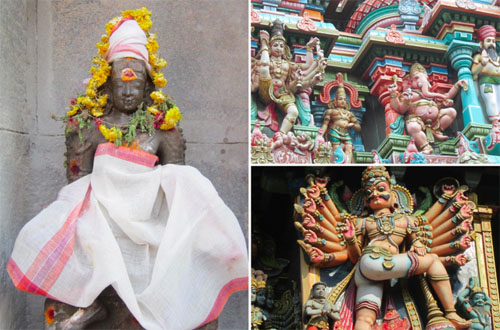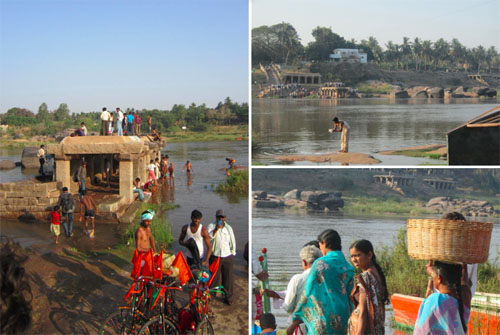Cochin or Kochi was our next stop after our wonderful home stay in Wayanad. From the information we had all read about Cochin, we were all looking forward to a big Indian city with a beautiful seaside old town. What we found instead once we were dropped at our hotel was a very smelly ordinary Indian town. Our hotel was on first glance, acceptable, but very quickly we discovered that the theme of the next two days would be one smell or another.
As I have already told you, we took the opportunity the first night to get prescriptions filled and were by that time so nauseous from the smells of the open sewers in the streets that we opted to have a dinner of peanut butter sandwiches in our room. But how to do that without touching something dirty? I managed to rig up something with plastic bags and toilet paper and using Marc’s Swiss Army knife we had our sandwiches with tomatoes and carrots for dessert. Our hotel room was humid and smelly and we felt the walls closing in on us.
It was one of those nights where we asked ourselves how we ended up in such a dump? But we sucked it up, turned the fan on high, opened all of the windows and prayed that we would fall asleep quickly.
In the morning we were all taking a boat cruise which included a city tour of the Old Town of Kochi which included viewing the famous Chinese fishing nets, which are not seen anywhere outside of China, visit the historical sites in Mattancherry/Fort Kochi - Jew Town, Jewish synagogue, St. Francis church (Vasco de Gamma’s original Tomb), Santa Cruz Basilica, Dutch Palace, Fort Kochi beach.

Our boat cruise got off to a bad start and went down hill from there. Al and Anja had booked a private boat and guide for us, but when we arrived, we were told that we were part of a tour that included Indian tourists as well. Our guide would do the tour in English and Hindi. Not to worry, he was very professional, we heard him tell Anja. But in fact we could not understand his English at all so he may as well have been speaking Hindi! And he was not much of a guide at all. He simply alerted us to the things we were seeing from the boat with little explanation. He also told us that due to it being Friday, we would not be able to get into many of the sites on the tour. On top of that he seemed to be in a big rush to get us through each stop on the tour once we got off the boat.
The Chinese fishing nets were indeed a highlight and we all wished for more time and a better explanation of how it worked. Luckily there is Google so I can actually fill you in.
This fishing method was introduced by the Chinese explorer Zheng He. They were set up between 1350 and 1450. The beaches of Cochin are beautifully lined with these Chinese nets. They are locally known as Cheenavala. In Cochin, the Chinese nets are suspended in the mid air all along the coast. The nets are set up on bamboo or teak poles and are basically fixed land installations. These nets are horizontally suspended over the sea, giving an appearance of a huge hammock. For balance, these nets are counter balanced by stones tied to ropes. Each net spreads over an area of about 20 meters.
The technique of fishing by Chinese fishing nets differs from the technique of ordinary fishing nets. While fishing by Chinese fishing nets, the nets are submerged into the sea, kept for a few minutes and then raised by six fishermen. All of these six fishermen must maintain the balance while picking the net out of water.
A basket full of fish is retrieved from the net and offered for sale fresh from the sea. Across the street there are restaurants where your fresh fish can be cleaned and cooked. We didn’t manage to have a fish dinner, but it looked very inviting.
Our tour guide rushed us through this very interesting stop on the tour and we were less than pleased.
From here we were taken to a street of shops and directed to the closed Synagogue and Church. We were quickly told that there are seven Jewish families left in Kochi who look after the Synagogue. He didn’t have much more to say about the community or the history of this very unique Jewish community.
Once again Google to the rescue:
Among all the commonwealth countries of the world, the Jewish Synagogue, Kochi is the oldest existing synagogue. The prosperous Jewish trading community built it in 1568 AD. It was partially destroyed in the 1962 war. Later it was rebuilt by the Dutch. This speaks for the historical importance of the monument.
As far as the architecture of the Jewish Synagogue in Kochi is concerned, it is wrapped with painted Chinese tiles. None of these tiles resemble the other. In the mid 18th century, the clock tower was attached to the main building of the synagogue. The interior of the Jewish Synagogue at Kochi is adorned with Belgian chandeliers and grand lightings.
When I asked the guide how many Jewish families lived here in the heyday of this once vibrant community he told me 25,000 families. It seems that almost the whole Jewish community left Kochi for Israel after India’s Independence in 1949. I found that quite strange and needed a better explanation. Had they been forced out for some reason? After a bit of research I found that the reason for leaving was their fear of assimilation into greater Indian culture. This Jewish community was so entrenched in their religion and traditions that they felt their only hope of keeping their true identity was to emigrate to Israel.
Interestingly, this is probably the only significantly large Jewish community in recent history, who left a country of their own free will and not due to persecution.
I found the story very intriguing and felt that it was really too bad that the tour guides in Kochi did not know anything about a very significant part of Kochi history. I also learned from Leslie that one of the Kochi Synagogues has been reconstructed in the Israel Museum in Jerusalem and that a large number of Kochi Jews reside in the coastal city of Ashdod in Israel. I tried to find some more information on how they got there but haven’t found anything yet.
We found only a few signs of the rich Jewish past in this city. We visited the Jewish Cemetery and noticed one shop with Jewish artifacts. Other than that, it was a town full of Indian trinkets, clothing and spices.
Looking back, there was a rich history to appreciate but somehow we missed the mark in where we stayed, and the tour guide that was provided. If we had it to do over again, we would have stayed in Jew Town (I hate that term) and watched the fisherman balance their nets at our leisure. We would have chosen fish from their basket and had a fish dinner on the side of the “lake” (Actually, the body of water separating the main city of Cochin and the original town is clearly a channel, not a lake. Marc questioned why our guide continually referred to it as a lake. Our guide explained that the government of Cochin recently designated this body of water a “lake” because they thought it would be more appealing to tourists! India, you gotta love it.). We would have come on a day when the Synagogue was open, or have attended Friday night services in the oldest Synagogue in this part of the world. Next time!
There was one highlight of our stay in the new town of Cochin. It was the Indian coffee house just up the street from our smelly hotel. Crystal, who had done this trip eight years ago, remembered this coffee shop and steered us all there. The place was buzzing with locals. They served inexpensive local fare that was amazingly good. Coffee was strong and sweet and the dosas to die for. We had several meals there, served by men in turbans. The very local experience took our minds off the smelly streets below.
On our last night in Cochin we attended a Kathakali performance. Google to the rescue again to give you some background.
Kathakali is one of the oldest theatre forms in the world which originated in this area of India. Kathakali is a group presentation, in which dancers take various roles in performances traditionally based on themes from Hindu mythology, especially the two epics, the Ramayana and the Mahabharata.
One of the most interesting aspects of Kathakali is its elaborate make-up which we were allowed to watch been applied.
The technique of Kathakali includes a highly developed language of gesture, through which the artist can convey whole sentences and stories. The body movements and footwork are very rigorous. To attain the high degree of flexibility and muscle control required for this art, a Kathakali dancer undergoes a strenuous course of training, and special periods of body massage.
The extraordinary costumes and make-up serve to raise the participants above the level of mere mortals, so that they may transport the audience to a world of wonders.
The next morning be boarded our blue bus for a short ride to the ferry dock where we picked up our houseboat for an amazingly pleasant trip down the backwaters of Kerala.
More on that later!



























































